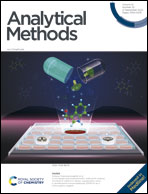A nucleic acid dye-enhanced electrochemical biosensor for the label-free detection of Hg2+ based on a gold nanoparticle-modified disposable screen-printed electrode†
Abstract
In this paper, a nucleic acid dye-enhanced electrochemical biosensor based on a screen-printed carbon electrode (SPCE) modified with Au nanoparticles (AuNPs) was designed for the detection of Hg2+ in water. AuNPs were modified on the surface of the disposable SPCE through the electrodeposition of HAuCl4. Subsequently, thiolated DNA probes were immobilized on the AuNP-modified electrode surface by Au–S reaction. After Hg2+ was bound with a DNA probe by thymine (T)–Hg2+–thymine (T) mismatch, the DNA probe was folded into a hairpin structure where positively charged GelRed molecules were embedded into the double-stranded part of the hairpin. Thus, the current of [Fe(CN)6]3−/4− increased significantly on account of the decreased electrostatic repulsion at the electrode surface. Under the optimized experimental conditions, the peak current of [Fe(CN)6]3−/4− exhibited a good linear relationship with lgCHg2+ in the concentration of Hg2+ linear range of 0.1 nM to 500 nM, and the limit of detection (S/N = 3) was calculated as 0.04 nM. The electrochemical sensor also exhibited excellent selectivity for Hg2+ in the presence of nine interfering ions, including Na+, Fe3+, Ni2+, Mg2+, Co2+, Pb2+, K+, Al3+ and Cu2+. Meanwhile, the developed electrochemical sensor was tested in the analysis of Hg2+ in tap water and river water samples, and the recoveries ranged from 81.0 to 114%. Therefore, this nucleic acid dye-enhanced electrochemical biosensor provided the advantages of simplicity, sensitivity, and specificity and is expected to be an alternative for Hg2+ detection in actual environmental samples.



 Please wait while we load your content...
Please wait while we load your content...